

Search form

- MaineBoats Blog
New life for an historic Friendship sloop
Tuesday, july 10th 2018.
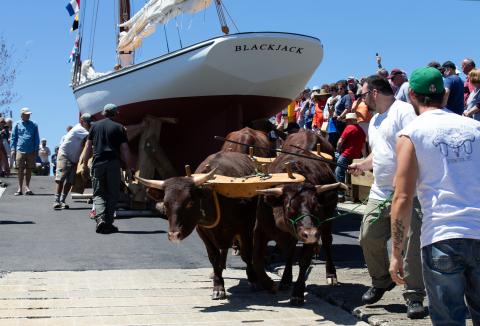
Story by Polly Saltonstall
Photos by Alison Langley
Over a century after she first slid down the ways at Wilbur Morse’s yard in Friendship, the newly restored Friendship sloop "Blackjack" was launched Saturday July 7.
The drawn-out ceremony included bagpipers, fiddlers, and many helping hands, including a team of four oxen from Cox Kennel and Farm in Woodstock, Maine, that helped pull the 33-foot vessel from the Sail, Power, and Steam Museum to the Rockland, Maine, public landing at Snow Marine Park. Capt. Jim Sharp said that was how the boat might have been launched 100 years ago. Sharp and his wife, Meg, own and run the museum.
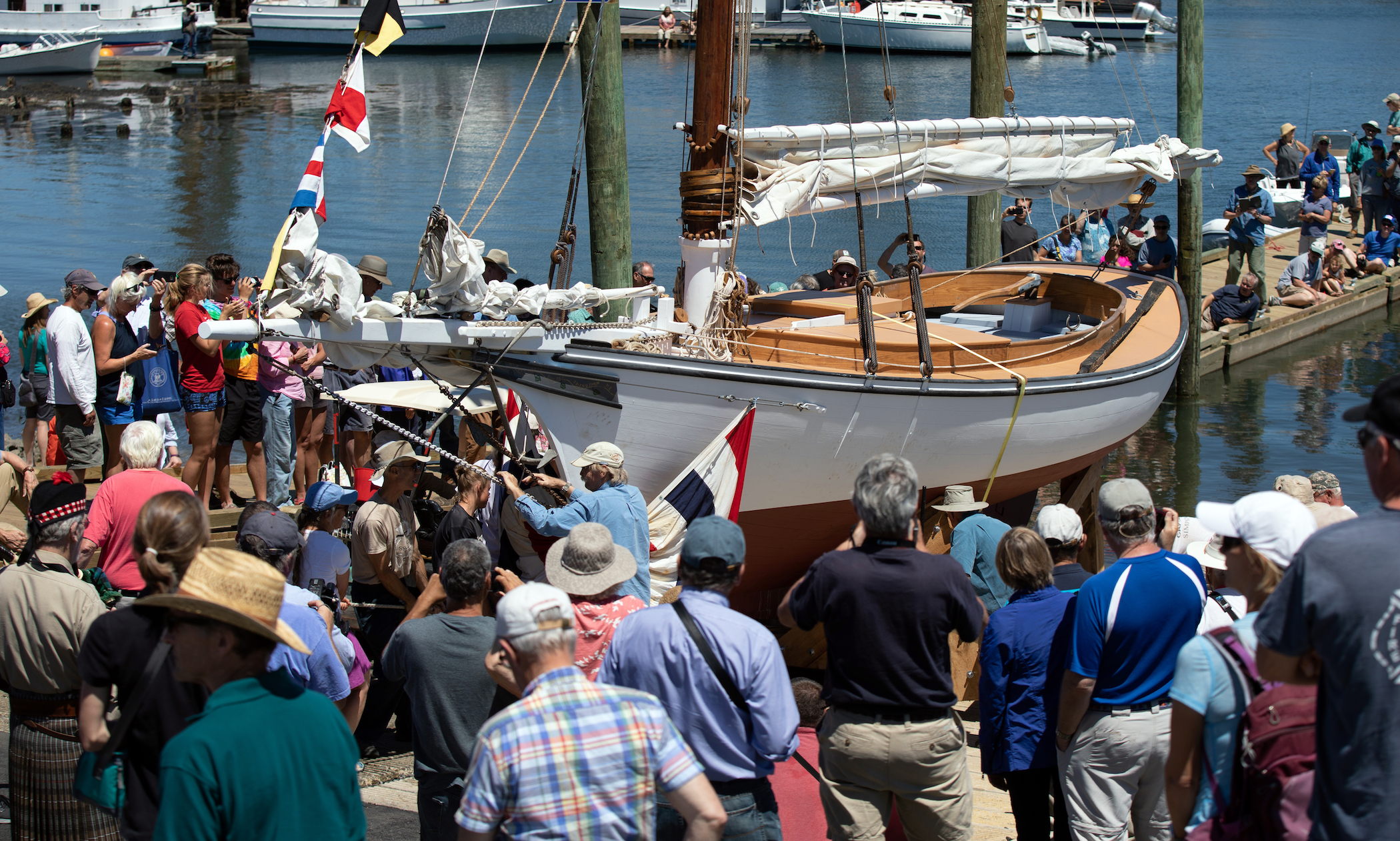
The Friendship sloop was the most popular small workboat on the Maine coast before the lobster fishery was revolutionized by the gasoline engine. They featured a wedge keel, a wide cockpit and shallow deck. Their gaff rig made them easy to maneuver, which was useful because often they were worked by just one man. The type became known as the Friendship sloop because in the late 29th century, Morse was a principal builder, turning out a boat in his Friendship-based shop almost every three months from the 1880s until 1927 when he retired.
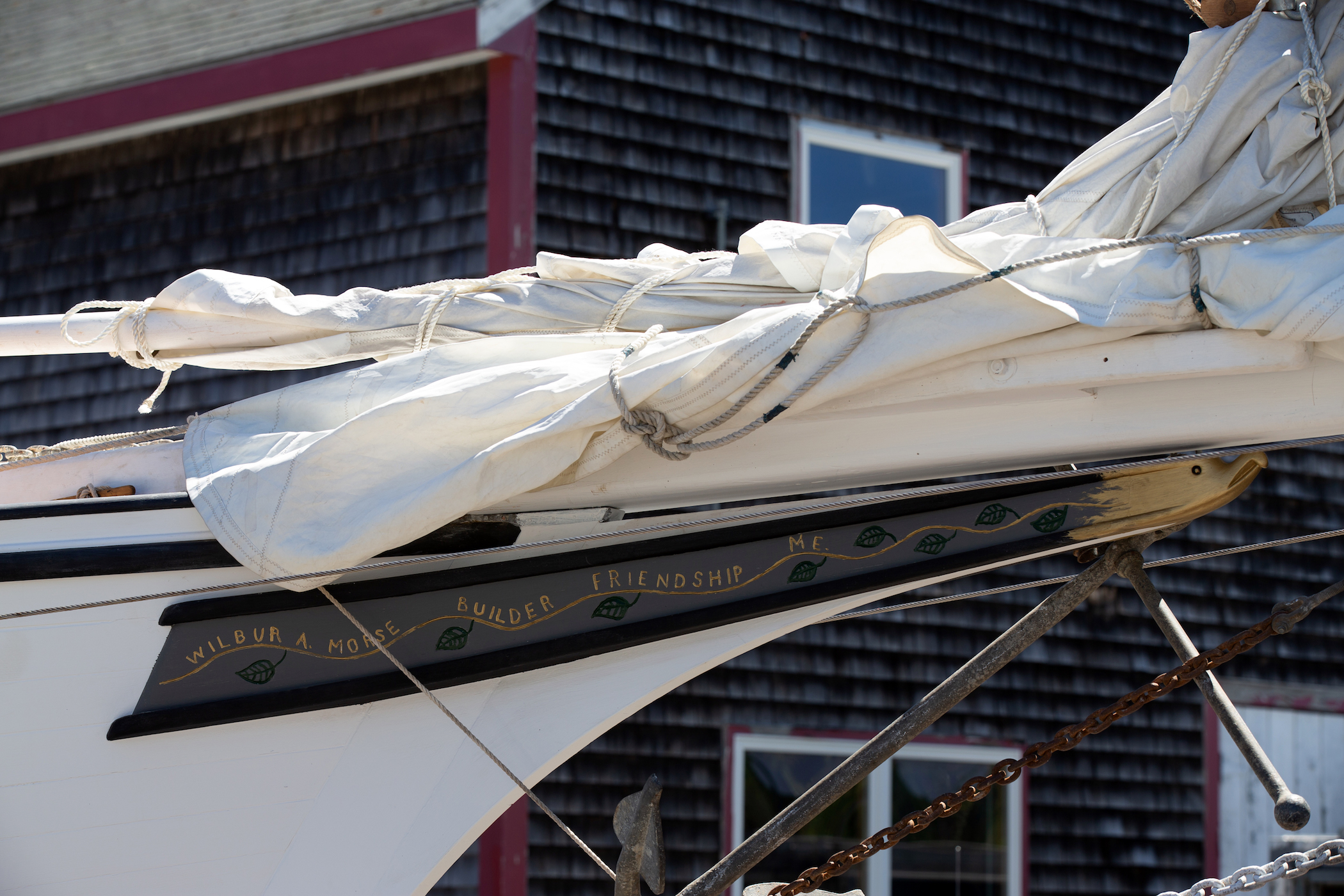
Sharp acquired Blackjack from out-of-state owners, who were overwhelmed by the massive restoration required. “We rebuilt the vessel entirely,” he said. “She had a broken keel, all the frames and the planking was gone and the sheer was lost.”
The rebuild process included consulting with wooden boat expert Maynard Bray and boat builder Ralph Stanley, who has built several Friendship sloops, on the design and techniques Wilbur Morse might have used. The wood for the new frames and keel came from a stand of English oak that had been planted long ago in Friendship — to keep the genes in the right place, said Sharp. A team of master builders that included Jim Loney, Tim Clark, and Garrett Eisele, worked with a group of dedicated volunteers on the project. They planked Blackjack below the waterline with cedar and above with native pine.
“We replaced everything but the transom,” said Sharp.
This is not the first launching in modern times to use an oxen team. Back in 1965 Jim Rockefeller built a friendship sloop in his shop on Bald Mountain some eight miles from the water. On launching day, two teams of oxen hauled the boat down to Rockport Harbor for its launching. Teams of oxen were used again for a launching in 1977 at Rockport Marine.
At Blackjack's launching, Sharp’s wife Meg christened the boat before it was slowly pushed into the water by volunteers. He said the vessel would be used to take passengers out in Rockland Harbor to learn about lobstering using old wooden traps, joining Persistence, another friendship sloop restored at the sail and steam museum and launched several years ago.
Blackjack will be on display on the docks at the Maine Boat & Home Show in Rockland on Sunday, August 12. For more information, or to purchase tickets to the show, go to maineboats.com/boatshow.
Share this post:
Related posts.

Digital Edition Available ×
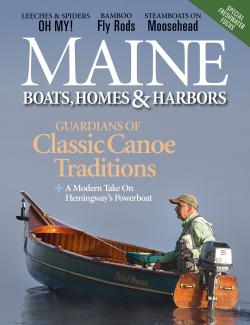
Can't get to the store to buy your magazine? We deliver the stories of Maine's coast right to your inbox. Sign up here for a digital edition .
2023 Maine Boat & Home Show ×

Join Us for the Maine Boat & Home Show !
Art, Artisans, Food, Fun & Boats, Boats, Boats
August 11 - 13, 2023 | On the waterfront, Rockland, Maine
Click here to pre-order your tickets.
Show is produced by Maine Boats, Homes & Harbors magazine.

- Forum Listing
- Marketplace
- Advanced Search
- About The Boat
- Boat Review Forum
- SailNet is a forum community dedicated to Sailing enthusiasts. Come join the discussion about sailing, modifications, classifieds, troubleshooting, repairs, reviews, maintenance, and more!
Friendship 31 sloop
- Add to quote
I am interested in any info on sailing characteristics of this type of boat. I do coastal cruising in Fla and New England. It seems that the different sails offer possibility of adequate performance in a wide range of conditions; Thanks, Jim Marron.
I assume that you happen to be talking about a gaff rigged Friendship Sloop that is 31 feet long and not a particular model such as the Friendship 31. (There is a Dutch company that produces modern boats called Friendships) The Friendship sloops were named for Friendship Maine where they were originally built. They were a development of the earlier Essex sloops and were adapted to be used in the lobster fishery around the start of the twentieth century. Their low freeboard and deep sheer made it easier to haul the lobster traps aboard. They carried a compartively large sail gaff rigged sloop sail plan with very small headsails and a huge mainsail and many were rigged to carry fidded upper mast and a gaff topsail which really have them an enormous sail plan. These were boats that were designed to reach well and for their day they were excellent sailing boats. Of course their day was over a hundred years ago. In their day, their hull form was really revolutionary. Compared to the working watercraft that preceeded them, Friendship sloops shared some things in common with the current direction on yacht design. For their day, Friendship sloops had comparatively fine bows with their center of buoyancy quite far aft. While these were easily driven hulls for their era, they were intended to be quite burdensome and had a lot of wetted surface resulting in huge amounts of drag as compared to a modern design or even a vessel of that era that was intended to be a yacht. One hundred years ago, before winches, the Friendship Sloops huge mainsail and small jib rig proportion was an ideal single-handing rig although timing the running backstays in a jibe was not the easiest of jobs to do single-handed. In those days all of the mechanical advantage came from blocks and tackles and keeping the headsails small and the mainsail big meant that the big mainsails were self-tacking and had multi-part tackles on their throat and peak halyards. I don''t know how much experience you have sailing gaff rigs, but they are a fun rig to sail. If you care about performance at all or get caught in changable conditions, they require a lot of adjusting and fiddling. Getting a proper adjustment between the peak and throat halyards is a bit of an artform in and of itself. This is a rig that is optimized for driving a comparatively tender for their relatively high drag hull on a reach. They are not at their best either beating or running. While the Friendship Sloops were moderately weatherly for their day, by any objective standard any halfway decent modern design will out sail them on all points of sail but especially upwind. Despite the rhetoric that seems to suggest that Gaff rigs are simple, there is nothing terribly simple about them. They have a lot of moving parts and huge quantities of running rigging that tends to have comparatively short lifespans. Due to the geometry of a gaff rig, preventing chafe is a constant battle. While they do have a lot of sails, sail changes were frequent. Friendship sloops are comparatively tender and with their low sheer and large cockpits, swampings were pretty frequent. Boats going lost was a pretty common event even in thier comparatively protected inshore fishery. They needed a lot of drive to be able to be sailed in lighter winds, but that meant striking the gaff topsail and tieing in a reef as soon as things picked up. In a breeze these boats can really develop a massive weather helm that was generally handled by a ''manila Mike'' or later by worm gear steering that was at best high friction and slow responding. These were boats that really require a lot of skill to sail, but that is part of the fun of them. As cruisers an authentic Friendship Sloop tended to be quite cramped down below for a boat of their length (especially the wooden ones) but offered a nice size cockpit. There have been a number of nice yacht adaptations of the basic Friendship Sloop design but there are also some very silly designs that pretend to be Friendship Sloops in name only and offer none of the virtues of a true Friendship Sloop. For Florida, authentic Friendship sloops tend to be pretty deep. They take up a lot of dockspace for their length on deck. A 31 foot authentic Friendship Sloop would typcially be 41 feet from the tip of their bowsprits to the tip of their boom (which overhangs the transom) which means paying for a lot more dockage than a boat with that kind of interior space usually needs. With their comparatively poor manueverability docking can be a bit of a trick as well. The originals were kept on moorings. I guess that the bottom line on these boats is that if you are into re-enacting the past and get a kick out of understanding what our forefathers had to deal with,and if you are handy at markinspike seamanship and the highh maintenance of a gaff rig, and if you are comfortable with the compromises in sailing ability and seaworthiness, and if you are a very skilled sailor, boats like these are really neat to own and sail. But if you simply want to have a boat that you can just get aboard and go sailing, then these are probably not the best choice. Respectfully, Jeff
JeffH, I''ve often wondered about Friendship sloops myself, and you gave an excellent thumbnail description. I do have one more question: why do they have such high displacement? They seem very heavy for their size.
Jim, You should read Nick Finneran''s book STANIEL CAY. Two teenagers find an old Friendship sloop in the mangroves in Biscaye Bay in 1948. They fix up the boat and go sailing around the Caribbean. Great sailing adventure story. See www.nickfinneran.com
Another good Friendship Sloop book is Joe Richards series on the "Princess". Joe bought a wreck of an old Friendship after WWII and fixed the old girl up. I actually knew Joe and worked for his brother at a boat rental place in the mid-1960''s. Jeff
Jeff_H said: Another good Friendship Sloop book is Joe Richards series on the "Princess". Joe bought a wreck of an old Friendship after WWII and fixed the old girl up. I actually knew Joe and worked for his brother at a boat rental place in the mid-1960''s. Jeff Click to expand...
drynoc There are a lot of reasons that they were as heavy as they were. Some related to the intent of thier construction which was fairly robust to take the abuse of being worked. Some had to do with workmanship which was crude and cheaply done (double sawn frames and chunk forefoots.These boats were seen as somewhat disposible.) Some weight came from the very heavy rig. Much of the weight came from carry cobblestone internal ballast. It takes a lot of ballast to get much stability out of a low density placed that high in the hull. But also as a work boat the Friendship sloops had to be able to carry a proportionately large amount of cargo. Jeff
friendship sloop sailing and handling well i just got in from a couple of days offshore the westcoast of vancouver island with my fifty foot friendship sloop. What a pleasure to sail...i singlehand it with a alado roller furnling jib and a gaff rigged main. i built this boat, steam bent yew frames, the best materials throughout...so although i have blocks and lots of ropes, once you practice a bit, raising and lowering the main is actually a peice of cake. ive owned plenty of glass sloops thirty feet and up and some multi hulls too and all in all they all have stuff to learn and they all have good and bad to deal with. the friendship sloop is a very stable boat due to width and ballast combinations and is infinitely adjustable. surprisingly it was well known for windward and ive been experimenting with it and shurely it points very well, as well as my previous glass sloop. you just have to have good sail shape and let it climb, its quite fascinating. the long sloped keel with its flat sides keep a good grip on the sea, and having the max draft at the rudder post makes for a pleasant ride in following ten foot plus seas as ive just experienced. Now there are a lot of armchair sailors out there, and there are a lot of lazy jacks now days, too fat to haul in a line, too pooped at an early age to do anything but press buttons.....so dont fret, try one of the old timers out and learn......its worth the effort and they look a heck of a lot better than they make em now and probably ride the sea better too..........thanks sincerely mike
The Dictator model, Jarvis Newman's 31' Friendship is an excellent boat. True, it is not a modern sloop. But it performs well, pointing high and sailing fast for a classic boat. (I've sailed on one). Jeff gives a good thorough description of the type, though I only know of one that capsized and sank, that while racing. I owned and sailed a 26' Pemaquid for several years and found her very seaworthy, great in big seas. If you're very interested, contact Jarvis, he still brokers the boats.
I had not remembered that he bought Princess that early. Its been a very long time since I read any of his writings. In the mid-sixties he was still talking about restoring "Princess" like it happened yesterday. Joe was a colorful guy, and as a kid, he seemed way bigger than life to me. His brother, whose name escapes me, ran a sailboat rental and sailing school on Manhasset Bay. As a kid, I worked at Sigsbee's Marine during the week, which maintained the wooden Pennant sloops that Joe's brother rented, and on the weekend I worked at the rental as a boat boy, prepping the boats at the beginning of the day and cleaning them up at the end of the day, and giving sailing instructions when requested or sailing with non-sailors to keep them out of trouble. When I think about it today, I am amazed that even back in those simpler times, it somehow made sense to send out total non-sailors in leaky old wooden boats without an engine with only a 15 year old kid as the sailing instructor or chaperone, especially when I consider how little I knew then about sailing compared to what I know today. I terms of my reference to capsizing and swamping, this refered to the older working Friendships which were worked in all kinds of weather, generally single-handed or with only a man and a boy. The yacht version tend to have higher density ballast, placed lower in the keels, and less sail area for their displacement giving them more stability and less likelyhood to capsize or founder. One of the glass versions that i sailed on had a self-bailing cockpit as well. Jeff
Interesting. I'm familiar with the history too. Friendships had a great reputation for seaworthiness, even back in the day. The one I know of that sank was an original I think, but racing in blustery conditions with topsails set iirc. I think the replicas that I've seen have about the same rig as the old ones, mine did. You remember Schneider Pennant Sloops? My first keelboat was a 20' model built around 1961. I loved it.
Friendship type Sloops were originally "designed" for the Cod Fishing industry, many ballasted with pigs of iron secured under removable wooden slats. "Designed" is probably a misnomer as the design evolved as necessary for a working boat over an extended period. The low freeboard allowed as small crew to recover nets more easily and a Friendship Sloop with a belly full of fish was near impossible to capsize. The rigs were overlarge and low to provide the power necessary drag nets, hence the Gaff rig that provided an enormous sail area relative to the size of the boat. While Friendship's are enormously stable and would track like they were on rails once set up, unloaded they had horrible weather helm and tracked only with a "fisherman's reef" and lots'a rudder. Joe modified his boat to a "Bermudian Rig" in the mid-60's while living in Key Biscayne, a move he described as a "transformation", tho' that move horrified more traditional watermen. At one point he was challenged to a race by another owner of one of Princess's sister ships (with the traditional rig) and Joe proceeded to sail rings around that boat, literally, from Key Biscayne to Coconut Grove and back. (That event is described in his second book.) Joe was always "rebuilding" Princess. (I doubt if at any time there was ever a stick of wood aboard that boat that was more than 30 years old after he finished his post WWII rebuild in '47 or '48.) I suspect even now he's in Heaven's boatyard fitting newly milled Mangrove ribs into Princess's spirit with his tools tied to strings so he doesn't loose them in the sand/sea. "Mangrove--perfect stuff, last a 1,000 years..." FWIW...
I've owned one Friendship and sailed on several. None were hard to handle. Mine balanced so well that light lashings on the helm allowed her to self steer.
- ?
- 176.4K members
Top Contributors this Month
50th Anniversary Collectors Issue - September/October Issue No. 300 Preview Now
The Friendship Sloop BLACKJACK
By tim clark.
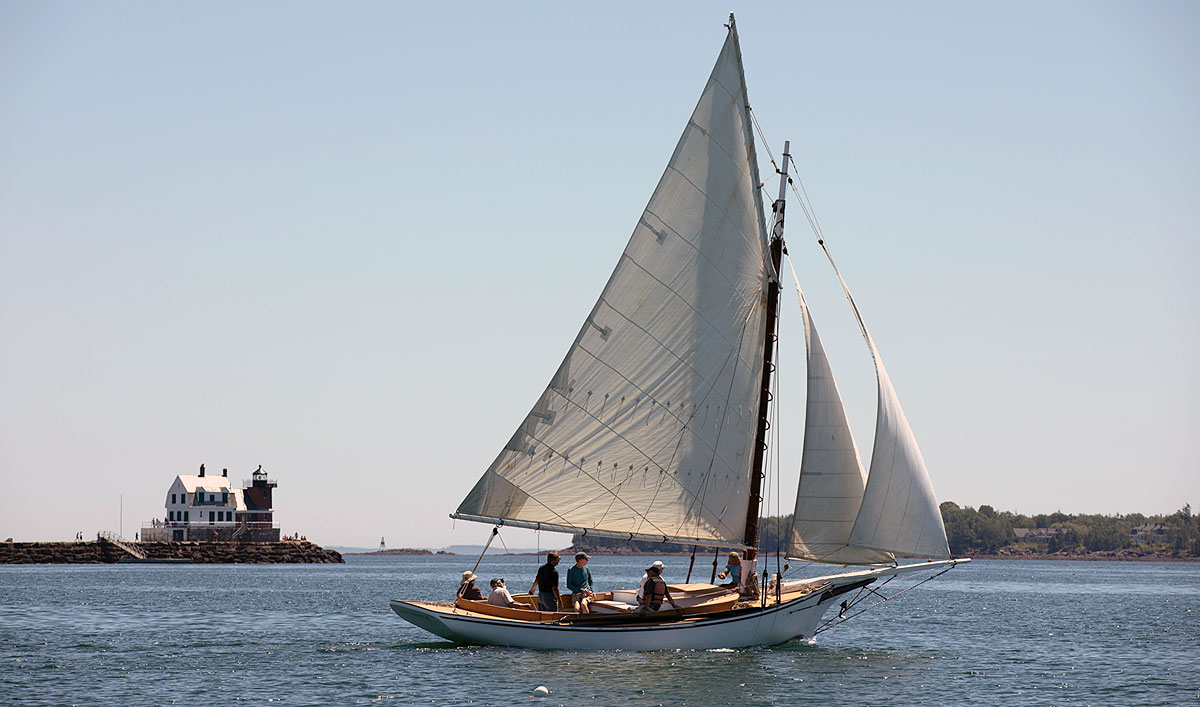
ALISON LANGLEY BLACKJACK, a 33′ Friendship sloop built in 1900 by Wilbur Morse, sails in her home waters of Rockland, Maine. She was extensively restored by professionals and volunteers at the Sail, Power & Steam Museum, which is her new home.
T he Maine sloop-boat, the sailing predecessor to the modern lobsterboat, is an icon of Maine’s maritime heritage. As a professional boatbuilder living and working in Maine who has a particular interest in historic workboats, I had always hoped that I might one day have an opportunity to build or restore one of these so-called Friendship sloops. In the summer of 2016, such an opportunity came my way in the most satisfying way I could imagine: I was asked to restore an original working sloop built by the most notable builder of the type, Wilbur Morse of Friendship, Maine.
Morse greatly influenced the development of Maine sloop-boats, and he was likely their most prolific builder, having launched some 500 of them in a roughly 20-year span starting in about the 1890s. This number does not even include other types of fishing boats and yachts that he went on to build over the course of his career. While most sloop-boat builders of the time preferred to work alone or with just a helper or two, Morse practiced production-style building, employing several workers and streamlining the process as much as possible.
My restoration project, BLACKJACK, is a 31-footer and one of about a dozen Morse boats surviving today. She was built in 1900, and her original name is lost to time, which leaves her history as a fishing boat undocumented. BLACKJACK seems to have been retired from her role as a working boat in the 1920s, around the same time that most of her contemporaries were, and she subsequently became one of the lucky few that caught the eye of an admiring yachtsman.
She underwent a substantial refit for pleasure use sometime in the 1930s, and it was presumably during this time that she was reconfigured with a larger, rather box-like cabin trunk for more headroom and volume belowdecks. Extending the cabin’s length aft decreased her cockpit size dramatically; the interior layout was changed to that of a proper cruising boat; and an inboard engine was added. She would retain this configuration and be used as a private yacht until the 1970s, when she began serving in a daysail charter operation out of Mount Desert Island in downeast Maine.
By the early 2000s, BLACKJACK needed significant structural repair, and she received many sister frames and new bottom planking. Despite these efforts, the years had taken their toll. Her checked and weathered timbers no longer remained firmly fastened, and rot was pervasive throughout.
A well-intended couple from Rhode Island purchased her in 2010, but a few years later they concluded that the project would be too costly for them. Correspondence with the Friendship Sloop Society led them to the Sail, Power & Steam Museum in Rockland, to which the boat was donated. That’s how I ultimately became involved.
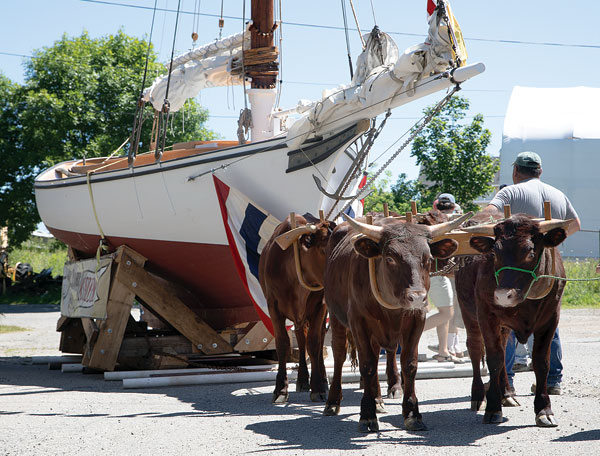
ALISON LANGLEY
Capt. Jim Sharp and the restoration crew envisioned launching the boat as Morse might have done in 1900, and so they arranged for a team of four oxen to haul BLACKJACK to the ramp at the public landing in Rockland, a couple of hundred yards from the workshop where she was restored. Bagpipers and fiddlers are just out of frame.
T he Sail, Power & Steam Museum exhibits a wide array of artifacts and information, but its primary focus is on the industrial maritime history of Rockland and the surrounding region, including that of lobster fishing and sloop-boats. As such, the museum had already taken in a few sloops in need of redemption. One of them, a strip-planked and fiberglassed version whose construction was begun in the 1960s and left incomplete until after the builder died, was finished by museum staff and volunteers, and launched as a daysailer for museum visitors and other paying passengers.
When the museum’s founder, Capt. Jim Sharp, received the call about BLACKJACK, he knew the opportunity to acquire and restore an authentic Morse sloop was a rare prospect indeed. They already had a fine representation of the type, but BLACKJACK would be a perfect candidate for a historically accurate restoration. Jim accepted the offer.
Jim Loney, a resident of Friendship who lives less than a mile from where BLACKJACK was built, was hired to lead the restoration. A skilled woodworker with a diverse professional background, he and a crew organized the shop space and solicited donations of tools and timber, landing several thousand board feet of excellent white oak for structural members and white pine for hull planking.
When BLACKJACK arrived, her shape was terribly distorted. Her keel was precariously connected and had somehow cocked over to the port side. While stored in Rhode Island, the heavily ballasted hull was supported by jackstands that were pushing up into her planking. The cabin trunk was collapsing. Before she was transported to Maine, volunteers from the Friendship Sloop Society removed hundreds of pounds of rusty metal ballast and supported the cabin trunk and deck with bracing and posts set on the keel.
With the boat in the shop, Loney and the museum’s volunteers began the tedious process of deconstructing BLACKJACK while the donated timber, delivered as logs, was being milled. When enough of the deteriorated components had been removed, they began replacing her backbone, rudder trunk, and floor timbers. The stem, though dark with patina and embedded with iron fastenings, would remain in place, and by the end of the project it was likely the only original piece left. The existing transom planks and vertical framing would also remain, but they appeared to be only a few decades old.
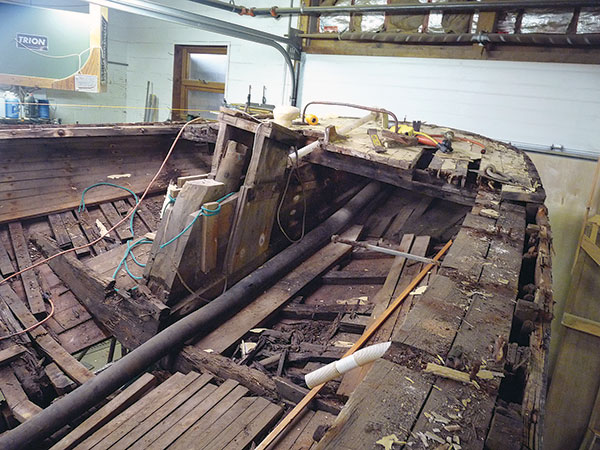
MAYNARD BRAY
BLACKJACK came to the museum in poor condition. Here, with the cockpit mostly disassembled, it is clear that her afterdeck had at one point been partially replanked with 2x4s. The rotten floor timbers are also evident here.
The hull was coaxed to the original shape and held there with bracing and ribbands, then new steam-bent oak frames were installed. Her stern counter had drooped severely over time, and her once-proud sheer had flattened out. As part of the process, maritime historian Maynard Bray, who is technical editor of this magazine and grew up in Rockland within sight of where BLACKJACK was being restored, was called upon to assist Loney with reestablishing the sheerline.
Planking and reframing then began, and along the way, Loney and Bray recorded the hull shape and Bray produced a lines drawing. Using this and a photo of the nearly identical Morse-built GENIE W of 1898, he also drew a profile and deck arrangement.
I n May 2016, work had to be suspended due to a lack of funding, and Loney moved on to another project. By the end of that summer, I was hired to complete the restoration. My first order of business was to finish the planking. The donated pine had run out, so we purchased eastern white cedar for the rest of the job. It was a convenient place to begin: the planking routine gave me the time to get to know the boat and do the necessary research for the next stages. I wanted to have a basic understanding of how the original sloop-boats were built, so my first bit of detective work led me to two sources: a Friendship sloop named VOYAGER and a Muscongus Bay sloop named RANGER.
Friendship sloop enthusiasts know VOYAGER. She was the catalyst for the Friendship Sloop Society when, in 1960, her owner, Bernard MacKenzie, felt inspired to organize a sloop regatta in Maine after she performed so well in a race against modern boats. She had been built by Morse’s brother, Charles, in 1906. Charles had once worked in Wilbur’s shop, but eventually opened his own—working with a smaller crew at a slower pace.
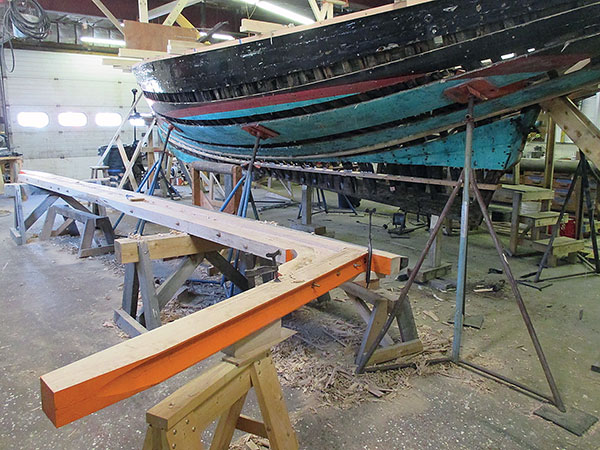
With her straight keel and sternpost, BLACKJACK’s backbone required few curved rabbet lines and little compound three-dimensional shaping, so the new pieces were more or less exact copies of the old ones. Shipwright Jim Loney, who led this phase of the project, rebuilt the boat’s structural components as accurately to the originals as possible.
I heard through the grapevine that VOYAGER was still intact and sitting in her present owner’s back yard only a few towns over. With the owner’s permission, I studied the boat and her construction details. Although she was in poor condition, many of her components were original; the only alterations were the typical ones for yacht conversions: changes to her cabin trunk, cockpit, and accommodations. Her structural members and general design were remarkably similar to BLACKJACK’s, so I supposed it safe to assume that Charles had borrowed a good deal of Wilbur’s methods.
Then I went to the Maine Maritime Museum in Bath to examine RANGER, which is cleverly displayed with her starboard side fully restored and her century-old port side left original. She is included in an exhibit on the Maine lobster fisheries alongside a collection of other historic lobsterboats of various types.
The similarities between VOYAGER and BLACKJACK are not surprising, considering they were built only six years apart by two brothers, one having worked in the other’s shop before setting out on his own. But I was not expecting to find such consistency with RANGER, a so-called Muscongus Bay centerboarder built two decades before VOYAGER. Surprisingly, her structural components were exactly the same as the Morse brothers’ boats. While every sloop builder had his particular methods, several features clearly carried over from one yard to the next over time.
Prominent details on most Friendship sloops include the carved trailboards and billethead that adorn their dramatic clipper bows. Neither trailboards nor clipper bows are functionally necessary, but it seems that they were universally present on Morse’s sloops. When the time came to deal with BLACKJACK’s trailboards, I realized that the carvings that had arrived with her were not only too deteriorated to repair but also inconsistent with the photographic and physical evidence of Morse’s work. I would guess that they were made to replace the originals during the 1930s refit. Using old photographs showing a few Morse sloops in profile, I approximated the dimensions and shapes of BLACKJACK’s original gammon knee, trailboards, trail knees, and billethead. I also had a close-up shot from the 1970s of original Morse trailboards, and a private collector loaned me a trailboard made by Charles Morse that had a carved vine almost identical to Wilbur’s. Mike McCune, a talented woodcarver who had helped work on BLACKJACK from time to time, produced the trailboard carvings based on my research while I focused on the billethead.
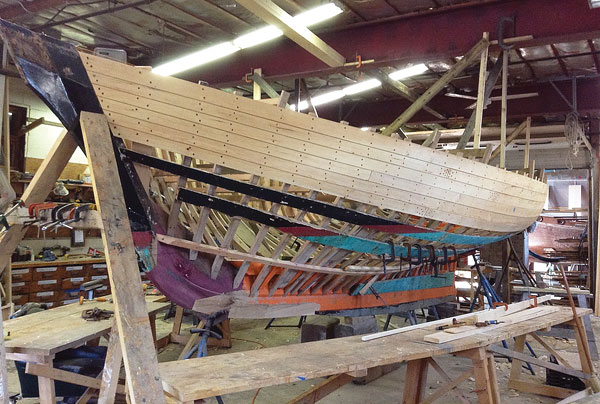
The new gripe, visible here at the forefoot of the hull, is made of purpleheart and is the only piece of non-native timber in the boat. None of her planking was salvageable, and no effort was made to replicate her plank lines. Author-builder Tim Clark says, “We lined her off according to what made sense.”
Morse’s signature billethead design was a very rudimentary depiction of an eagle’s head. There are several originals on display at the Friendship Museum, and although their sizes vary, the design does not. As skillfully carved and pleasing to the eye as BLACKJACK’s existing gold-leafed eagle head was, it did not fit with our efforts to re-create the vessel as a historically accurate representation. So, using the originals as prototypes, I carved a new billethead, sized appropriately to the dimensions of the trailboard assembly.
Work progressed steadily and simultaneously elsewhere with several small production-style projects. Wooden cleats, deadeyes, and blocks had to be patterned and produced using various jigs and repetitive multi-step processes. Marshall Merriam, an experienced welder, volunteered to fabricate the new metalwork including chainplates, straps for the new blocks, a new traveler and the modification of a salvaged one, and to clean and repair the spar ironwork.
Morse’s early sloops were mostly steered with a tiller. BLACKJACK arrived with a cast-iron wheel and steering gear that appears in all the existing photos of her, but I surmised that at some time in her life, these had been retrofitted in place of a tiller. We had originally planned to restore the helm’s components, since the particular wheel and gear assembly would have been used on early working sloops, whether installed during a vessel’s construction or added later. Ultimately we decided on tiller steering, and so the crew welded a custom steel rudderstock fitting and cheeks that could be through-bolted to a black locust tiller.
BLACKJACK’s spars were in very good condition, and only a few repairs and modifications were made to them. The mast was replaced during her 1930s restoration, and it is one of the finest pieces of tight-grained Douglas-fir I have ever seen, completely free of any checks or defects. Her original mast would most likely have been shaped from a spruce tree harvested locally, but there was never any reservation about keeping this beautiful and serviceable bit of timber.
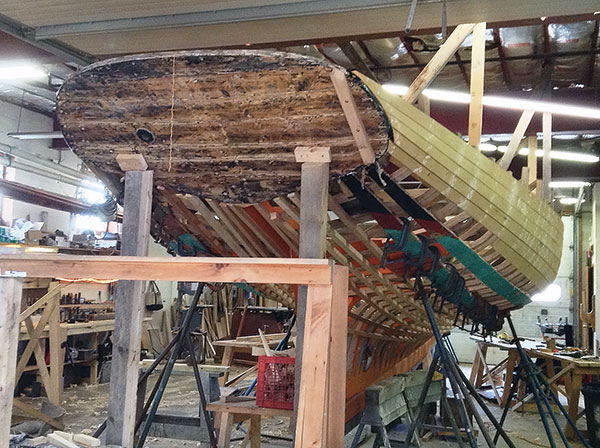
Friendship sloop hulls, especially in their after sections, are more complex than many contemporary yacht hulls, and BLACKJACK’s was especially tricky. Though the backbone assembly’s transition from sternpost to horn timber is simply built, the planking was a challenge in this area.
Despite our painstaking effort to build as faithful a Morse sloop as research would allow, practicality had to be considered—both for the boat’s longevity and for the museum’s budget. A common construction detail in Friendship sloops was a series of wide, scarfed-together timbers running fore-and-aft just inboard of the sheerstrakes, under the deck, and on top of the sheer clamps. These so-called lockstrakes served to strengthen the sheer, but only small sections had survived the boat’s various repairs. It was decided to save time and cost by omitting the lockstrakes in favor of more conventional beam shelves atop the sheer clamps. Bray drew up a deckbeam arrangement using this type of construction.
BLACKJACK would also have a fiberglass-sheathed plywood deck rather than the traditional sprung-plank laid deck, for durability and ease of maintenance. The plywood deck would also add rigidity and strength, negating the need for lockstrakes and blocking. Working sloops’ decks were most often painted, so after filling the fiberglass weave and applying a few heavy coats of flat buff paint, BLACKJACK’s deck did not appear glaringly different from an original painted laid deck.
Aside from these fairly inconspicuous departures, the remainder of BLACKJACK’s historical compromises are hidden from view. Silicon-bronze screws and bolts, polyurethane adhesives, epoxy, and other modern materials were used wherever they made sense for strength and longevity. Although these workboats were built to be strong, with beautiful lines and superior performance, they were built of local woods, turned out quickly at low cost, and were not expected to last more than a decade or two. In most cases, surviving original sloops have had many repairs and restorations over the years and have been gradually upgraded with better materials, increasing their resistance to decay.
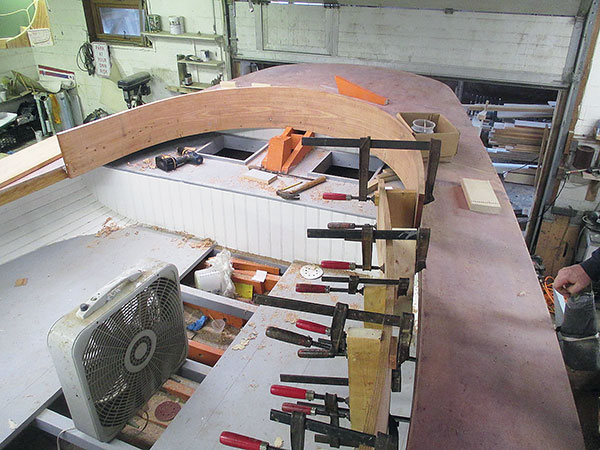
The vertical pieces of wood spaced out along the cockpit sides are clamping “cauls” used to keep the coaming from cupping while it is steam-bent into place. Farther aft, the author over-bent the coaming piece so that after springback it would fit to the curve.
In spite of our thorough research, we did not discover any further documentation of Morse’s construction methods; most sloop builders worked directly from carved half models, and they did not document their designs or building practices. They rarely built exactly the same boat twice. Photographs were invaluable for recreating the highly visible elements, but drawings of layout, joinery, components on deck, areas inboard of the coaming, and details inside the cuddy were nearly impossible to find. Many of these mystery details were educated guesses by Bray and me, based on the other sloops we studied or on what made practical sense. Even though built by Robert McLain and not Morse, Mystic Seaport’s 1904 sloop boat ESTELLA A, as depicted on drawings by Robert C. Allyn, served as a guide when all else failed.
When the time came to think about stepping the mast and setting up her new galvanized-steel shrouds, I considered how BLACKJACK’s existing rig was set up and what needed to be changed to represent an early working sloop. We moved some components to more closely match what we saw in the models and drawings we studied, but the setup we came up with is a baseline arrangement that can be adjusted and improved as future use dictates. The long-term hope for BLACKJACK is that she will demonstrate tending wooden lobster traps under sail (see WB No. 161), and the ease of handling through such a maneuver demands convenience and practicality that sailing for pleasure does not.
As BLACKJACK drew close to completion, I was offered another restoration opportunity I could not decline, and unfortunately, the timeline could not wait. Luckily my business partner, Garett Eisele, could take over for me while I continued researching and planning. When I stepped away, I had just finished installing the continuous elliptical steam-bent oak coaming and cabin trunk—a signature element on working Friendship sloops. Eisele completed the cabintop and a host of other details, and readied BLACKJACK for launching.
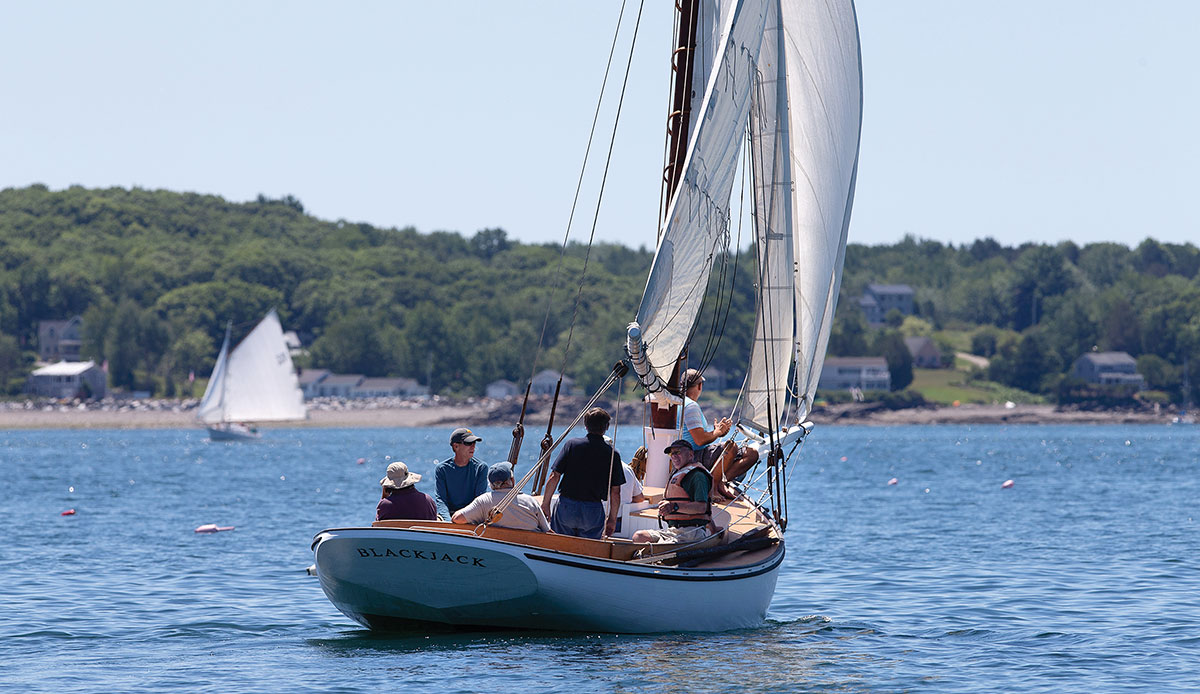
BLACKJACK’s sails are the Dacron ones that arrived with her. She will need new sails eventually, and Clark hopes they will be handmade of cotton.
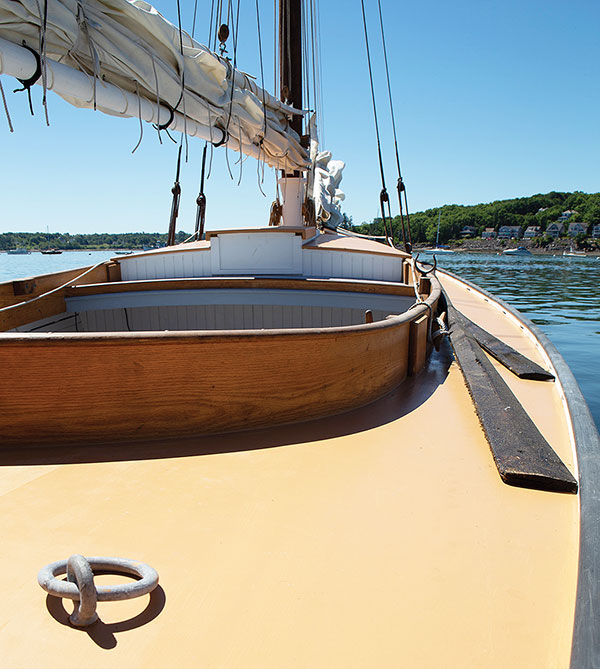
The elliptical shape of the continuous cabin trunk and coaming is an aesthetically pleasing design but also a practical one: it makes for a strong assembly with very little structural framing and few joints with the potential to leak over time. Sweeps from an unrelated display at the Sail, Power & Steam Museum will serve as appropriate propulsion for BLACKJACK when the wind fails.
Earlier, Capt. Sharp and I had discussed our vision for BLACKJACK’s launching and decided the proper thing was to do as Wilbur Morse might have done in 1900: We hauled her across the museum grounds with four “blue ribbon” oxen, preceded by a marching band playing fiddles and other instruments. During the fanfare, I wondered how surprised and honored Morse might have been to know that one of his workaday sloops would have survived 100 years to be rebuilt as an educational ambassador of Maine’s technological, industrial, and cultural heritage.
A few weeks after launching BLACKJACK, and following a few sea trials, Eisele and I had an opportunity to sail her. Despite imperfections and much-needed improvements to her sails and rigging, we were astounded by her graceful and predictable performance. I had been admiring her hull shape and thought it one of the finest-looking Friendship sloops I had ever encountered, but now she was proving herself to be just as close to perfection in function as she was in form. She balanced wonderfully, and when pressed by a gust she laid over until the toerail kissed the waves, and there she stayed, finding her equilibrium in just the right place. The wide, surfboard-like run aft maximized her hull’s hydrodynamic potential and provided substantial initial stability.

Tim Clark lives in Lincolnville, Maine, and is a partner of Clark & Eisele Traditional Boatbuilding, which specializes in repair and restoration. Previously, he’s worked at shipyards, boatshops, and maritime museums, and has sailed on schooners and square-riggers. He can be reached at www.clarkandeisele.com .
ACCESS TO EXPERIENCE
Subscribe today.
Publishing dynamic editorial content on boat design construction, and repair for more than 40 years.
1 YEAR SUBSCRIPTION (6 ISSUES)
Print $39.95, digital $28.00, print+digital $42.95, from online exclusives, extended content.
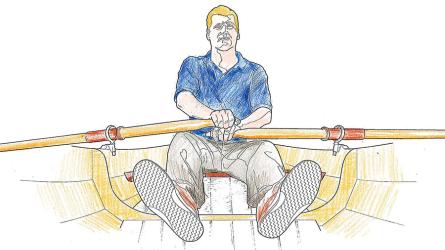
The Geometry of Rowing Craft
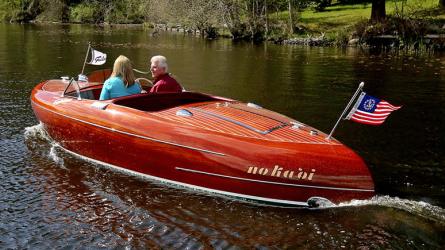
Fairliner Torpedo Redux
Whiskey plank.
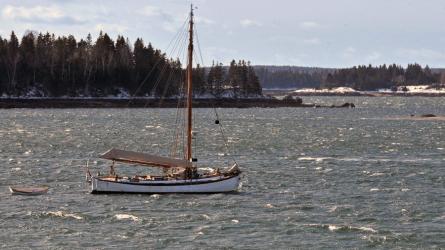
Winter Cruising in Maine
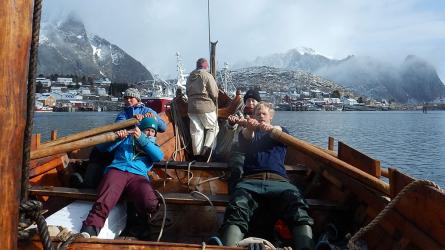
The Last of the Vikings
From the community.

Whitehall 16 ft. Sailing & Rowing Boat
16 foot Whitehall rowing and sailing boat. Maine built 1985.
Pre 1905 Warren Cole Adirondack Guideboat LOA 16′, 42″ beam
Restored in ME by Jonathan Minott (seen in WB "Launchings" July/Aug 2009).
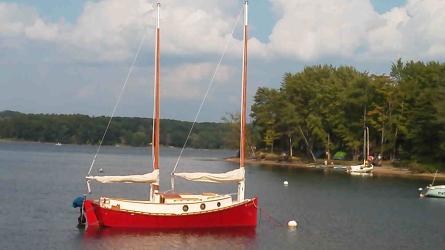
Learning Curve is for sale!
Learning Curve, a 24 foot cat ketch sharpie drawn by Karl Stambaugh.

Boat Launchings

Begun in 2020 blissfully ignorant of rabbets, rabbet planes, and most things nautical, she took m
- Bahasa Indonesia
- Slovenščina
- Science & Tech
- Russian Kitchen
Kostroma: The home of Russia’s Snegurochka, the snow maiden

Who is Snegurochka?
Snegurochka is the granddaughter and assistant of “Ded Moroz” also known as Father Frost, Russia’s version of Santa Claus. While Santa Claus is rumored to have residences in Finland and the North Pole, Ded Moroz is a proud patriot and maintains a home in Veliky Ustyug in the Vologda Region. His estate is a major tourist attraction receiving more than 200,000 guests a year. See Veliky Ustyug: The Russian Santa's Home .
Snegurochka does not have roots in Slavic mythology and only came into being in the late 19th century. However, to many Snegurochka appears to be as eternal as Russia itself.
Snegurochka is born

There were predecessors to Ostrovsky’s version. Alexander Afanasyev, considered the Russian equivalent of the Brothers Grimm, wrote a story in 1869 about a character called “Snegurka.” The tale tells involves the poor peasants Ivan and Marya, who build a doll made of snow that comes to life.
In Ostrovsky’s version Snegurochka is the daughter of Spring the Beauty and Father Frost. She longs for human companionship, but lacks the capacity to love. Her mother bestows this ability on her, but as she is made of snow, she melts when her heart warms after she falls in love.
By the reign of Nicholas II, Snegurochka had become associated with winter holiday celebrations. She was part of Christmas events until the Soviet Union banned religious holidays in the years after the Revolution. She was revived when New Year’s became the major winter holiday, replacing Christmas, in 1935. Since then Snegurochka, who had now become Father Frost’s granddaughter (instead of his daughter), has become a mainstay of holiday parties all over Russia. Along with her grandfather, she usually arrives bearing gifts.
Snegurochka’s Kostroma

The hotel has a special New Year’s package from Dec. 31 until Jan. 2, with a packed itinerary that includes a New Year’s party, a 1980s dance party the following night, a traditional New Year’s Eve sauna, a visit to the Ice Palace and a special lunch featuring old Kostroma recipes. This package is aimed at families and childcare services will be provided on Dec. 31. It is safe to assume that Snegurochka and her grandfather will join the party: hotel-snegurochka.ru/2015 .
The shop, Souvenirs from Snegurochka , features designer linens, handmade toys and handicrafts traditional to the area.
There is also the recently opened Snegurochka's residence . She offers tours and different interactive programs everyday from Wednesday until Sunday. Children can hold their birthday parties there and classes are offered on everything from making dolls to holiday decorations.
Snegurochka becomes a global star
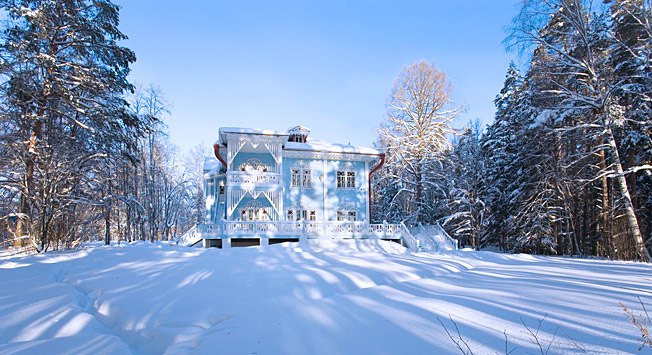
Nationally, she is linked with the city’s identity as one of the lead characters in the Russian National Dance Show “Kostroma” in Moscow. Popular among foreigners, it tells the story of ancient Rus’ and placing Snegurochka at its center has done much to cloud her humble provincial origins. See www.nationalrussianshow.ru
Famous Slovenian poet Svetlana MakaroviÄ released a fairy tale based on the character titled, “Snegurochka” affirming her lifelong love for Russian children’s tales. In 2004 American artist Ruth Sanderson, who specializes in illustrated Christmas books, released a book called, "The Snow Princess" , also based on you know who.
How to get there
By car: Take highway M8 from Moscow to Yaroslavl and from there follow A113 to Kostroma. Approximate travel time is 4 hours. It's important to leave Moscow at the right time to avoid the usual traffic jams.
By train: Night trains depart daily from Yaroslavsky Station. Tickets for coupe seats cost about 2000 rubles ($38) one-way.
All rights reserved by Rossiyskaya Gazeta.
to our newsletter!
Get the week's best stories straight to your inbox
- Historic Kostroma: an ancient Russian city on the banks of the Volga
- Russian Winter Is Coming
This website uses cookies. Click here to find out more.
- All Listings
- Privacy Policy
1978 27′ CLASSIC FRIENDSHIP SLOOP “OCEAN ROAR” ** MAJOR PRICE REDUCTION **
Description
** MAJOR PRICE REDUCTION, NOW $12,500 **
A Friendship Sloop with an interesting history: featured on 2 television commercials… for Zocor and Kleenex, and formerly owned by Senator Chris Dodd who sailed it with his buddy, Ted Kennedy. A traditional gaff-rigged Friendship with triple head sails, topsail and mainsail, sleeps 4, cockpit for 8, mahogany planking on oak frames and a 25 HP Westerbeke diesel. These sailboats were the originalMaine lobstering boats before internal combustion engines were used. Stored in a dry barn for the last 5 years.
Designer : Eldridge McGuiness
Builder : J Phillips Ham
LOD : 27′
LOA : 37′
BEAM : 9’6″
DRAFT 4’6″
Construction :
Mahogany / white oak, bronze
Worm gear steering
25hp Westerbeke
Morse controls
Gear ratio : 1 : 1
2 blade prop
Down below :
sleeps 4 people
Galley w/ sink & icebox
Sails & rig :
“OCEAN ROAR” is a traditional gaff rigged FRIENDSHIP SLOOP w/ triple headsails & topsail,
Hollow sitka spruce spars
Dacron sails
Additional equipment :
Cockpit & berth cushions
Ground tackle
Basic electronics
Safety equipment
**CONTACT** Glenn Schroeder Barnegat Bay Yacht Brokerage 609-312-8263 [email protected]
TO SEND EMAIL CLICK ON RED EMAIL BUTTON BELOW ** THE “CLASSICS “ARE WHAT WE SELL **
Thank you, Glenn Schroeder
Featured Listings
More from barnegat bay yacht brokerage, 1976 32′ persson-built ss sloop “aurora”, 1965 25′ fenwick williams catboat “cimba” $39,900, 1966 41′ custom cruising yawl “bulls eye”, 1970’s 25ft pemaquid friendship sloop “luna”, 1959 33′ alden malabar sr. “hirlas”, 1987 menger 17′ catboat, 2021 14′ arey’s pond racing catboat, 1993 22′ custom catboat “trick or treat”, the catboat man, 2008 com-pac suncat 17 ft. catboat “silver girl”, you may also like..., 2002 main ship pilot. 34 , 4lha-stp yanmar , 54ft hysucat performance motor yacht, 2020 – stingray 206 cc. , power source marine, cruisers yachts model: 390 sports coupe. redmond boats and yachts, welcome to world of nor-tech hi-performance boats .first coast nor-tech, new 22′ emergency landing craft – all aluminum, mobile boat mechanic longbeach, 60′ egg harbor sportfish 1989. welcome to atlantic yacht & ship, inc, 2018 sailfish 242 cc offshore tournament package.

Popular Boat Brands
- Boston Whaler
- Chris Craft
- Grady-White
- Grand Banks
- Ocean Alexander
BoatNation.com is a member of the following associations:
- International Marine Association ®
- Marine Industries Association of South FL
- International Yacht Brokers Association
Friendship 26
The friendship 26 is a 26.57ft fractional sloop designed by jac. de ridder and built in fiberglass by friendship yachts (nl) since 1978..
The Friendship 26 is a moderate weight sailboat which is a reasonably good performer. It is very stable / stiff and has a low righting capability if capsized. It is best suited as a day-boat. The fuel capacity is originally very small. There is a very short water supply range.
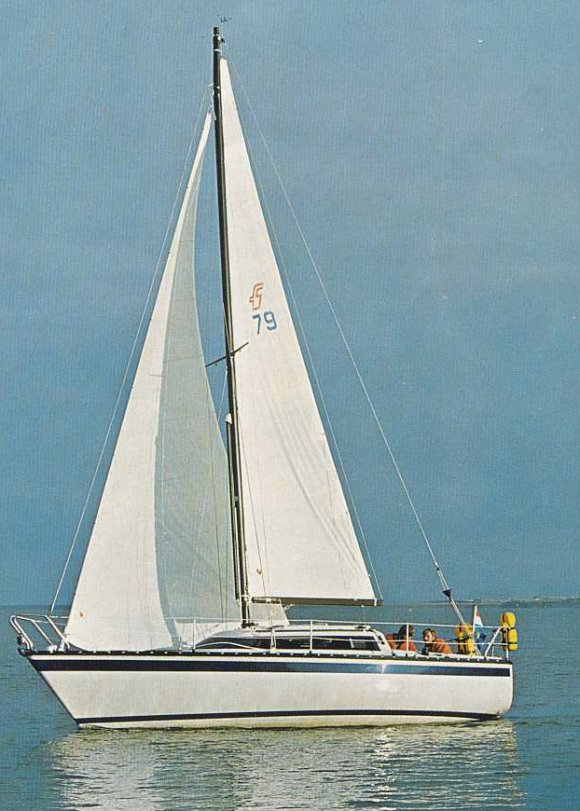
Friendship 26 for sale elsewhere on the web:

Main features
| Model | Friendship 26 | ||
| Length | 26.57 ft | ||
| Beam | 9.02 ft | ||
| Draft | 3.61 ft | ||
| Country | The Nederlands (Europe) | ||
| Estimated price | $ 0 | ?? |
Login or register to personnalize this screen.
You will be able to pin external links of your choice.

See how Sailboatlab works in video
| Sail area / displ. | 16.80 | ||
| Ballast / displ. | 40.73 % | ||
| Displ. / length | 209.24 | ||
| Comfort ratio | 14.44 | ||
| Capsize | 2.30 |
| Hull type | Monohull fin keel with spade rudder | ||
| Construction | Fiberglass | ||
| Waterline length | 20.21 ft | ||
| Maximum draft | 3.61 ft | ||
| Displacement | 3869 lbs | ||
| Ballast | 1576 lbs | ||
| Hull speed | 6.02 knots |

We help you build your own hydraulic steering system - Lecomble & Schmitt
| Rigging | Fractional Sloop | ||
| Sail area (100%) | 258 sq.ft | ||
| Air draft | 35.76 ft | ||
| Sail area fore | 0 sq.ft | ?? | |
| Sail area main | 0 sq.ft | ?? | |
| I | 0 ft | ?? | |
| J | 0 ft | ?? | |
| P | 0 ft | ?? | |
| E | 0 ft | ?? |
| Nb engines | 1 | ||
| Total power | 10 HP | ||
| Fuel capacity | 7 gals |
Accommodations
| Water capacity | 16 gals | ||
| Headroom | 0 ft | ||
| Nb of cabins | 0 | ||
| Nb of berths | 0 | ||
| Nb heads | 0 |
Builder data
| Builder | Friendship Yachts (NL) | ||
| Designer | Jac. de Ridder | ||
| First built | 1978 | ||
| Last built | 0 | ?? | |
| Number built | 0 | ?? |
Modal Title
The content of your modal.
Personalize your sailboat data sheet
|

COMMENTS
Friendship Sloop in c. 1920 Fiberglass Friendship Sloop Bay Lady (launched in 1979) Diagram of a Friendship Sloop. The Friendship sloop, also known as a Muscongus Bay sloop or lobster sloop, is a gaff-rigged working boat design that originated in Friendship, Maine around 1880 and has survived as a traditional-style sailboat.
Friendship Sloop Society. Originally developed in the late 1800s as a working boat and fishing platform, the Friendship sloop has survived as a type and has become recognized as an American sailing classic. This is the story of a family of boats and how they weathered more than a century of change and transition, and why they still have a ...
The single-mast ships were once used for fishing. Now, they sail as a reminder of Maine's rich maritime history.Read the full story here: https://www.newscen...
The 32-foot Friendship sloop is a classic Maine vessel, built in 1902 as a fishing boat. "This boat was built in 1902, for a man named Dana Simmons in Waldoboro … and fished it until 1927," Andy Zuber said with some pride. "It did not have an engine, sold for 450 dollars with sails in 1902.". And for him and many other owners of these ...
The above Friendship 30 was one of the first Friendship Sloops made from fiberglass. LOD: 30.5 ft. Engine options: Volvo Penta MD2, 15.5 hp diesel. Osco 21, 21 hp diesel. Reported sail area above includes main, staysail and jib. Add main topsail and jib topsail. SA becomes 860 sqft.
THE FRIENDSHIP SLOOP— LOBSTERING UNDER SAIL The Friendship sloop was the most popular small workboat on the Maine coast in the years before the lobster fishery was revolutionized by the gasoline engine. Built quickly and inexpensively in boatshops up and down the coast, it was a fixture in most Maine harbors. ...
The Friendship Sloop has no real birth, but was gradually developed around 1880 from the fishing and lobstering needs of the men of Muscongus Bay on the Maine coast. It is certain some of these fishermen had seen a Gloucester fishing boat, and being impressed with lines, had incorporated some of its features into their own hull designs ...
Back in 1965 Jim Rockefeller built a friendship sloop in his shop on Bald Mountain some eight miles from the water. On launching day, two teams of oxen hauled the boat down to Rockport Harbor for its launching. Teams of oxen were used again for a launching in 1977 at Rockport Marine. At Blackjack's launching, Sharp's wife Meg christened the ...
Bringing together like-minded sailors and the sloops they love, the event provides the opportunity for a yearly gathering of the Friendship Sloop Society (FSS— fss.org), founded in 1961—a homecoming of sorts for many of the participants, who began taking part when they were toddlers in life jackets. "When the event started in the 1960s ...
The Friendship sloop remained in use as a fishing boat into the early 20th century, when motorized boats began replacing them. ... a devoted group that admired its look and sailing qualities seized upon it. The Friendship Sloop Society was founded in 1961, and the first of its annual sloop regattas, held in Friendship, Maine, drew 14 entries. ...
Maine. $12,500. Description: MAJOR PRICE REDUCTION, NOW $12,500. Description. A Friendship Sloop with an interesting history: featured on 2 television commercials for Zocor and Kleenex, and formerly owned by Senator Chris Dodd who sailed it with his buddy, Ted Kennedy. A traditional gaff-rigged Friendship with triple head sails, topsail and ...
DISCLAIMER: The Friendship Sloop Society does not sell sloops, has no financial interest in the sale of the below listed sloops and makes no statement as to the condition or seaworthiness of any sloop. This listing is provided as a service to current or potential members of the society and was compiled from advertisements in boating publications and from verbal and written communications with ...
The Dictator model, Jarvis Newman's 31' Friendship is an excellent boat. True, it is not a modern sloop. But it performs well, pointing high and sailing fast for a classic boat. (I've sailed on one). Jeff gives a good thorough description of the type, though I only know of one that capsized and sank, that while racing.
T he Sail, Power & Steam Museum exhibits a wide array of artifacts and information, but its primary focus is on the industrial maritime history of Rockland and the surrounding region, including that of lobster fishing and sloop-boats. As such, the museum had already taken in a few sloops in need of redemption. One of them, a strip-planked and fiberglassed version whose construction was begun ...
In 2015 Kostroma will celebrate all things Snegurochka from March 27-28. Located in a restored 19th century building near the waterfront, Snegurochka's Fairy Land is a snow maiden's paradise ...
Description. ** MAJOR PRICE REDUCTION, NOW $12,500 **. A Friendship Sloop with an interesting history: featured on 2 television commercials… for Zocor and Kleenex, and formerly owned by Senator Chris Dodd who sailed it with his buddy, Ted Kennedy. A traditional gaff-rigged Friendship with triple head sails, topsail and mainsail, sleeps 4 ...
The Friendship 26 is a 26.57ft fractional sloop designed by Jac. de Ridder and built in fiberglass by Friendship Yachts (NL) since 1978. The Friendship 26 is a moderate weight sailboat which is a reasonably good performer. It is very stable / stiff and has a low righting capability if capsized. It is best suited as a day-boat.
FRIENDSHIP 26. Save to Favorites . Beta Marine. BOTH. US IMPERIAL. METRIC. Sailboat Specifications Definitions Hull Type: Fin w/spade rudder: Rigging Type: Fractional Sloop: LOA: 26.57 ft / 8.10 m ... it will vary with the weights of fuel, water, stores and equipment. A boat's actual draft is usually somewhat more than the original designed ...
Friendship used sailboats for sale by owner. Home. Register & Post. View All Sailboats. Search. Avoid Fraud. ... 28.58' Ericson 29 foot sloop Madison County FL, Florida Asking $2,000. 30' Pearson Wanderer Northport, Michigan ... Crescent Sail Yacht Club Grosse Pointe Farms, Michigan Asking $12,000. 27' Pearson 27-2 Mathews, Virginia
Plyos is another old Golden Ring town. It's famous for being one of painters' favourite landscape subject. These days is more famous for Muscovite riches' nature-idilic playground. Beautiful in sunshine. How to get to Plyos: I wanted...
Sep 15, 2024 - Looking to get inspired on your trip to Kostroma? Immerse yourself into world-class art, exciting history, and mind-bending science. Check out the best museums in Kostroma to visit in 2024. Book effortlessly online with Tripadvisor!
Website. grad.kostroma.gov.ru. Kostroma (Russian: Кострома́, IPA: [kəstrɐˈma]) is a historic city and the administrative center of Kostroma Oblast, Russia. A part of the Golden Ring of Russian cities, it is located at the confluence of the rivers Volga and Kostroma. In the 2021 census, the population is 267,481.